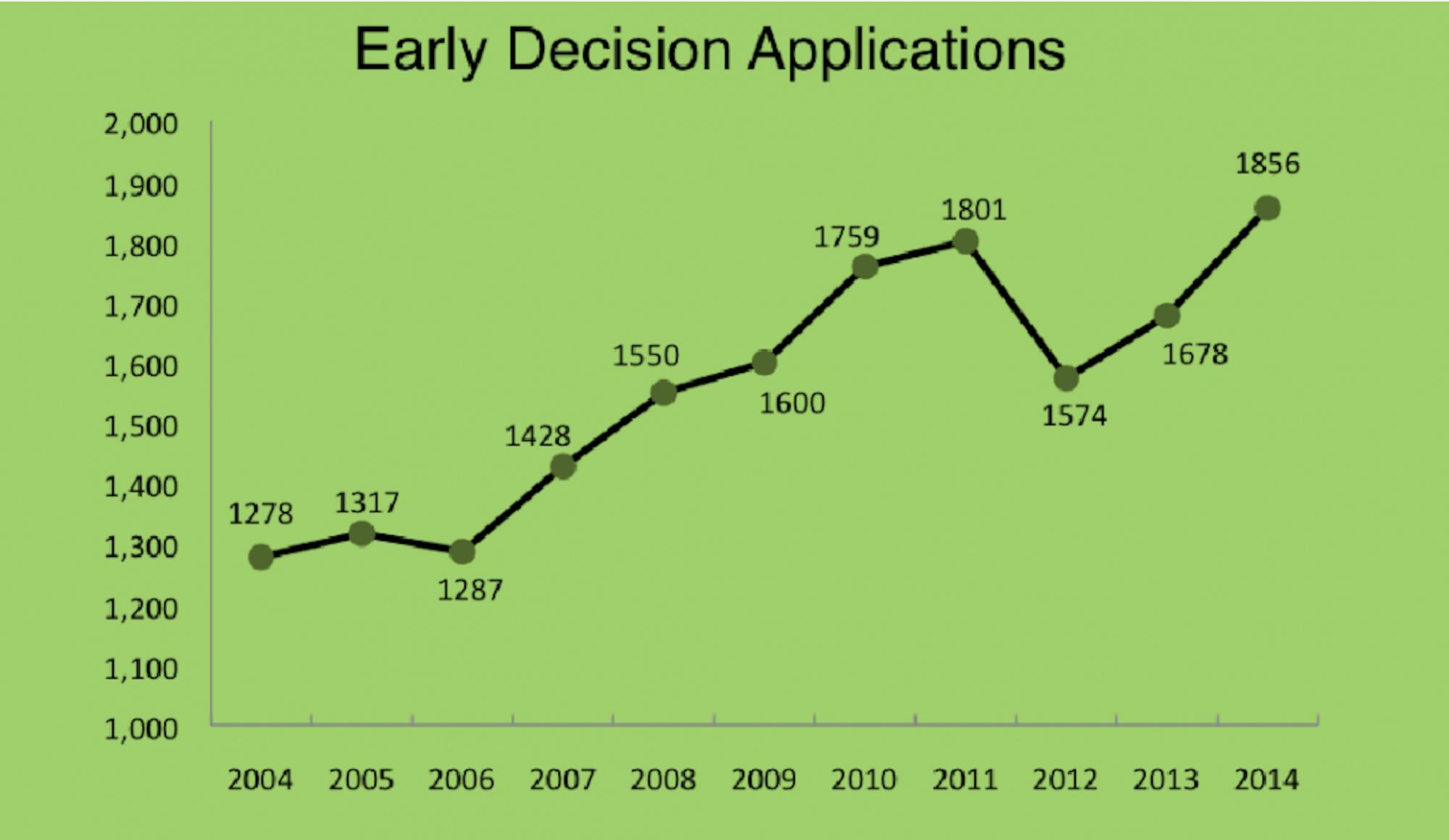Dartmouth saw a 10 percent increase in the number of early decision applicants this year, with an all-time high of 1,856 applications for the Class of 2019. This marks the second year that the College has seen an increase in the number of early applicants — following a 12.6 percent drop in early applicants for the Class of 2017 — coinciding with a national shift toward early admission programs.
Last year, 1,678 students applied early for the Class of 2018, and 469 were accepted, comprising 40 percent of the Class of 2018.
Dean of admissions and financial aid Maria Laskaris, who has traveled to Fairfield County, Connecticut, Baltimore and Northern New Jersey to meet with representatives from other universities, said this increase is not exclusive to the College.
While Laskaris said she could not point to one specific reason for the increase, she said specialized tours on campus have generated a greater interest in the College among applicants. These offerings include tours of the Neukom Digital Arts Leadership and Innovation Lab, Dartmouth Entrepreneurship Network’s Innovation Center and the Black Family Visual Arts Center.
Highly publicized negative events likely caused a decline in applications in previous years, Laskaris said, noting that recent applicants have seen Dartmouth’s efforts to address issues raised in previous controversies.
“People are seeing this as a place where these things are being addressed seriously and deliberately, and we’re making progress,” she said.
The College has also launched a new information session featuring local alumni in California, Laskaris said. The program highlights Dartmouth’s focus on experiential learning and promotes Dartmouth among applicants from the Silicon Valley area.
College consultant John Merrill, who said he helps between six and 10 students apply to Dartmouth each year, said he believes the electronic submission of the Common Application has boosted the number of early decision applicants at more selective institutions. Highly qualified students see the early decision process as a way of increasing their chances of being accepted to a highly-ranked school.
“Students who are very qualified see it as an advantage to get into one of the more selective colleges,” he said. “As they get better as a student with more test prep and everything else, I think they are certainly trying to advantage themselves by applying early,” Merrill said.
John Boshoven, a college counselor in Ann Arbor, Michigan, said that since the early decision applicant pool is smaller than the regular decision applicants pool, the higher percentage of students admitted does not mean the selection process is less rigorous.
“A higher percentage of a smaller group admitted is misleading,” he said. “Early decision applicants tend to be stronger applicants anyway.”
Applying early, Boshoven said, does not increase a student’s chances.
In the Ivy League, Columbia University, Cornell University, Brown University, Dartmouth and the University of Pennsylvania allow students to apply early decision, while Harvard University, Princeton University and Yale University allow students to apply single-choice early action. So far, only Dartmouth, Brown and Penn have released early admissions data.
Penn saw a 5 percent increase in early decision applicants this year, with a record 5,390 applications, according to The Daily Pennsylvanian. Penn accepted 54 percent of the Class of 2018 through the early decision process.
Brown, meanwhile, saw a decrease in the number of early applicants, dropping 2 percent from last year’s record high, The Brown Daily Herald reported. Brown saw an increase in international applicants, The Brown Daily Herald reported, and 8 percent of this year’s pool comes from the Midwest.
Boshoven said hailing from the Midwest may slightly help some applicants gain admission to schools on the East Coast, as the region tends to be underrepresented geographically, but he said he did not consider the advantage to be very significant.
Middle class students are probably the most underrepresented group in the early decision pool, Boshoven said, because they do not have the financial resources to commit to a school before seeing aid packages.
“It seems to favor the economically disadvantaged and the economically advantaged,” he said. “the big bubble in the middle of the middle class really can’t play the game.”
Dartmouth’s admissions office has yet to report demographic information on this year’s early decision applicant pool.
Parker Richards and Taylor Malmsheimer contributed reporting.




